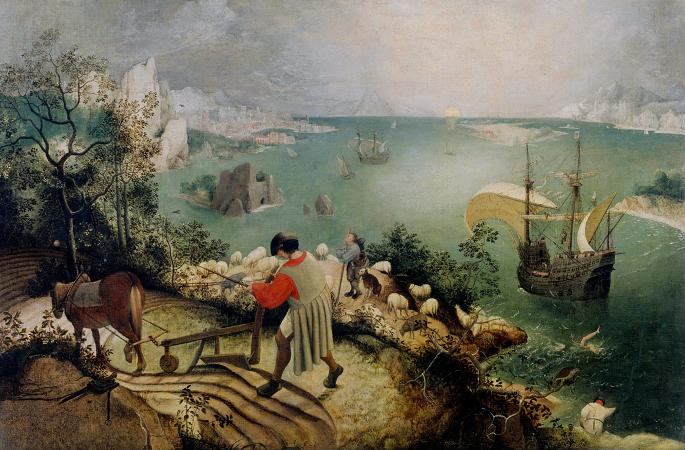Blind Leading Blind (1568). Oil on panel. 19 x 21. The painting reflects Bruegel's mastery of observation. Each figure has a different eye affliction, including corneal leukoma, atrophy of globe and removed eyes. The men hold their heads aloft to make better use of their other senses. The diagonal composition reinforces the off-kilter motion of the six figures falling in progression. It is considered a masterwork for its accurate detail and composition. Copies include a larger version by Bruegel's son Pieter Brueghel the Younger, and the work has inspired literature such as poetry by Charles Baudelaire and William Carlos Williams, and a novel by Gert Hofmann. Bruegel painted The Blind the year before his death. It has a bitter, sorrowful tone, which may be related to the establishment of the Council of Troubles in 1567 by the government of the Spanish Netherlands. The council ordered mass arrests and executions to enforce Spanish rule and suppress Protestantism. The placement of Sint-Anna Church of the village Sint-Anna-Pede has led to both pro-and anti-Catholic interpretations, though it is not clear that the painting was meant as a political statement. The painting depicts a procession of six blind, disfigured men. They pass along a path bordered by a river on one side and a village with a church on the other. The leader of the group has fallen on his back into a ditch and, because they are all linked by their staffs, seems about to drag his companions down with him. A cowherd stands in the background. Bruegel based the work on the Biblical parable of the blind leading the blind from Matthew 15:14, in which Christ refers to the Pharisees. According to art critic Margaret Sullivan, Bruegel's audience was likely as familiar with classical literature as with the Bible. Erasmus had published his Adagia two years before Bruegel's painting, and it contained the quotation Caecus caeco dux by Roman poet Horace. Bruegel expands the two blind men in the parable to six; they are well dressed, rather than wearing the peasant clothing that typifies his late work. The first blind man's face is not visible; the second twists his head as he falls, perhaps to avoid landing face-first. The shinguard-clad third man, on his toes with knees bent and face to the sky, shares a staff with the second, by which he is being pulled down. The others have yet to stumble, but the same fate seems implied. The faces and bodies of the blind men, and background detail including the church, are rendered in exceptionally fine detail. The backward-falling posture of the guide demonstrates Bruegel's mastery of foreshortening. Bruegel's settings tend to be fictional, but that of The Blind Leading the Blind has been identified as the village Sint-Anna-Pede, and the church as Sint-Anna Church. One of four surviving Bruegel paintings in distemper, the work is a techlein, a type of light painting that uses tempera made from pigment mixed with water-soluble glue. This medium was widely used in painting and manuscript illumination before the advent of oil paint. It is not known from whom Bruegel learnt its use, but amongst those speculated are his mother-in-law, illuminator Mayken Verhulst; his teacher Pieter Coecke van Aelst; and painter and illuminator Giulio Clovio, with whom he resided in Italy and whom he helped paint miniatures in distemper. Due to the high perishability of linen cloth and the solubility of hide glue, techleins do not preserve well and are difficult to restore. The Blind Leading the Blind is in good condition and has suffered no more than some erosion, such as of a herdsman and some fowl in the middle ground. The grain of the linen canvas is visible beneath the delicate brushstrokes. The work is signed and dated. The painting measures 86 cm x 154 cm, the largest of 1568. The austere tone is achieved through pigments in a colour scheme of mostly greys, greens, brownish-reds, and blacks. The diagonal movement of the bodies creates a dramatic tension in the foreground which is divided diagonally from the landscape background. The flat country features are distinctly Flemish, unlike in most of Bruegel's landscapes, in which he introduced foreign elements such as mountain ranges even into local scenery. In contrast to earlier depictions of the blind as beneficiaries of divine gifts, Bruegel's men are stumbling and decrepit, and portrayed without sympathy.
more...




